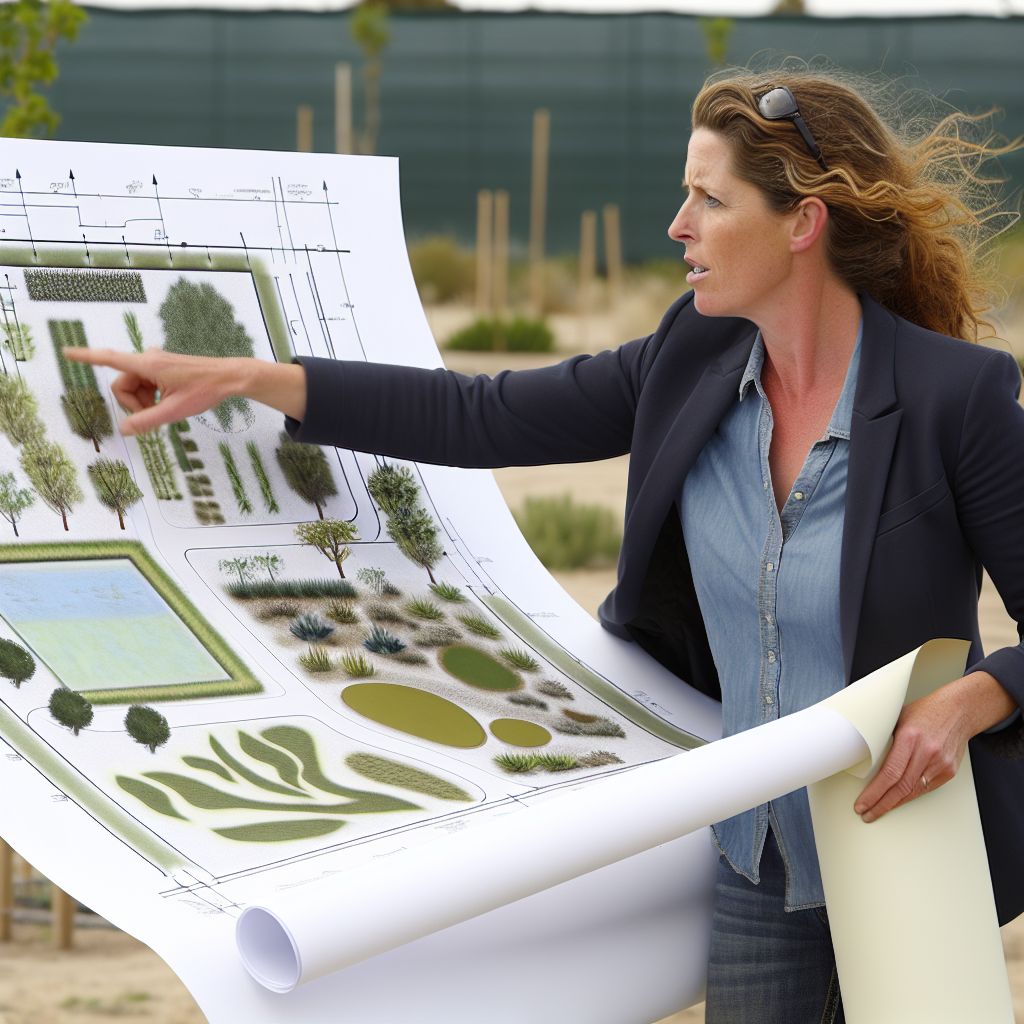Introduction:
A brief overview of landscape architecture reveals a diverse field that involves the design and planning of outdoor spaces.
Landscape architecture plays a crucial role in shaping outdoor environments, from parks and gardens to urban green spaces.
However, landscape architects face a myriad of challenges in their work, which can impact the quality and sustainability of these spaces.
Lack of Funding:
In the field of landscape architecture, one of the key challenges that practitioners often face is the lack of adequate funding for projects.
Limited budgets can have a significant impact on the quality and scope of projects.
This can hinder the ability of designers to implement innovative and sustainable solutions.
Ultimately, this can affect the overall success and impact of landscape architecture projects.
One of the ways to address the issue of funding shortages is to explore potential sources of financial support.
Grants from government agencies, non-profit organizations, and private foundations can provide much-needed funding for landscape architecture projects.
Additionally, seeking sponsorships from corporate partners or forming public-private partnerships can also help secure the necessary resources to bring projects to fruition.
Advocacy plays a crucial role in advocating for increased funding for landscape architecture projects.
Design professionals and industry organizations need to actively engage with policymakers, community leaders, and other stakeholders.
Highlighting the importance of investing in the built environment is essential.
By demonstrating the value and impact of landscape architecture on society, advocates can make a compelling case for allocating more resources to support the field.
While the lack of funding is a significant challenge in landscape architecture, there are potential solutions that can help address this issue.
By seeking out diverse funding sources, engaging in advocacy efforts, and making a strong case for investing in the field, landscape architects can work towards ensuring their projects have the necessary resources.
This helps to create meaningful and impactful spaces for communities to enjoy.
Sustainability and Environmental Concerns:
When it comes to landscape architecture, sustainability and environmental concerns play a crucial role in shaping the design and planning process.
As we strive to create beautiful outdoor spaces, we must also address the challenges of creating landscapes that are sustainable and environmentally friendly.
- Addressing the challenges of creating sustainable landscapes:
- The role of landscape architects in mitigating environmental impact:
- Exploring solutions such as incorporating green infrastructure:
- Implementing sustainable design practices:
- Educating clients and the public:
- Collaborating with other professionals:
One of the main challenges in creating sustainable landscapes is balancing the need for development with the preservation of natural resources.
Transform Your Career Today
Unlock a personalized career strategy that drives real results. Get tailored advice and a roadmap designed just for you.
Start NowThis requires careful planning and consideration of the environmental impact of design choices.
Landscape architects play a key role in mitigating environmental impact by incorporating sustainable design practices into their projects.
They are trained to balance aesthetics with ecological principles, ensuring that their designs have a positive impact on the environment.
To address sustainability and environmental concerns, landscape architects can incorporate green infrastructure into their designs.
Green infrastructure includes features such as green roofs, permeable pavement, and rain gardens, which help manage stormwater and improve air quality.
In addition to green infrastructure, landscape architects can implement sustainable design practices such as using native plants, minimizing water usage, and promoting biodiversity.
These practices help reduce the ecological footprint of landscapes and create more resilient outdoor spaces.
Another important aspect of addressing sustainability and environmental concerns is educating clients and the public about the benefits of sustainable design.
Landscape architects can advocate for green practices and raise awareness about the importance of preserving natural resources.
Collaboration with other professionals, such as engineers, biologists, and urban planners, is essential in creating sustainable landscapes.
By working together, landscape architects can leverage expertise from different fields to develop innovative solutions that prioritize environmental stewardship.
Sustainability and environmental concerns are key considerations in landscape architecture.
By addressing these challenges and implementing solutions such as green infrastructure and sustainable design practices, landscape architects can create outdoor spaces that not only look beautiful but also contribute to a healthier planet.
Delve into the Subject: Top Landscape Architecture Programs in the US
Site Constraints and Regulations:
When it comes to landscape architecture, one of the key challenges that professionals face is navigating site restrictions and regulations.
These constraints can often limit the creativity and functionality of a design, making it crucial for designers to find innovative solutions to work within these limitations.
Examine the challenges of navigating site restrictions and regulations:
- Site constraints such as limited space or environmental restrictions can pose significant challenges for landscape architects.
- Regulations related to land use, zoning laws, and building codes can also impact the design process and limit the possibilities for a project.
- Dealing with existing structures, utilities, and natural features on a site can further complicate the design process and require careful planning and execution.
Discuss the importance of understanding zoning laws and building codes:
- Understanding zoning laws and building codes is essential for landscape architects to ensure that their designs comply with regulations and are legally permissible.
- Zoning laws dictate how land can be used and developed, influencing everything from building height and setbacks to the types of plants that can be included in a design.
- Building codes establish safety standards for construction projects, including requirements for structures, materials, and accessibility features that must be considered in landscape design.
Offer tips for working within constraints to create innovative designs:
- Collaborate with local authorities and stakeholders to understand site restrictions and regulations from the beginning of the design process.
- Consider adaptive reuse of existing structures or features on the site to incorporate elements of the landscape into the design.
- Explore creative solutions such as vertical gardens, green roofs, and permeable paving to maximize functionality and sustainability within constraints.
- Use innovative materials and technologies to create interactive and engaging landscapes that meet regulatory requirements while pushing boundaries in design.
While site constraints and regulations can present challenges for landscape architects, they also offer opportunities for creative problem-solving and innovation.
By understanding and working within these limitations, designers can create unique and sustainable landscapes that enhance the environment and improve quality of life for communities.
Delve into the Subject: Choosing the Right Paint for Your Home’s Interior
Impact of Climate Change on Landscape Architecture
Increased temperatures and extreme weather events require landscapes to be more resilient.
Transform Your Career Today
Unlock a personalized career strategy that drives real results. Get tailored advice and a roadmap designed just for you.
Start NowRising sea levels and flooding threaten coastal designs and infrastructure.
Droughts and water scarcity affect plant selection and irrigation strategies.
Solutions for Creating Resilient Landscapes
Incorporate native and drought-resistant plants to reduce water usage and maintenance.
Install permeable pavements and green roofs to manage stormwater runoff.
Design multi-functional spaces that can adapt to different climatic conditions.
Importance of Climate Adaptation Strategies in Design
Ensures long-term sustainability and functionality of landscape designs.
Increases resilience to climate change impacts and extreme weather events.
Promotes biodiversity and supports ecosystems in the face of changing conditions.
By integrating climate adaptation strategies into landscape architecture, designers can create sustainable, resilient, and visually appealing environments that benefit both people and the planet.
Uncover the Details: Top Schools for Power Line Installer Training
Community Engagement and Stakeholder Collaboration
When it comes to landscape architecture, one of the key challenges is balancing the needs and desires of various stakeholders.
Different individuals and groups may have conflicting interests, making it crucial to find a middle ground that satisfies everyone involved.
- Understand the priorities of each stakeholder: To effectively address the needs and desires of stakeholders, start by understanding what matters most to each group or individual. This will help in creating designs that cater to their specific requirements.
- Open lines of communication: Engaging with stakeholders throughout the design process is essential. Regular meetings, updates, and feedback sessions can help in ensuring that everyone feels heard and valued.
- Seek feedback and input: Encouraging stakeholders to provide feedback and input on design proposals can lead to better outcomes. This collaborative approach not only enhances the quality of the design but also fosters a sense of ownership among the stakeholders.
- Transparency is key: Being transparent about the decision-making process and design choices can build trust and credibility with stakeholders. Transparency helps in avoiding misunderstandings and conflicts down the line.
- Conflict resolution: In cases where stakeholders have conflicting interests or concerns, it is important to address these issues promptly and effectively. Facilitate discussions, seek compromises, and find solutions that satisfy as many parties as possible.
Importance of Engaging with the Community
Engaging with the community throughout the design process is crucial for the success of landscape architecture projects.
By involving the community, designers can gain valuable insights, establish a sense of ownership, and create spaces that truly resonate with the people who will use them.
- Building trust and credibility: Community engagement builds trust and credibility with the people who will be impacted by the design. This trust is essential for successful collaboration and long-term project success.
- Understanding local needs and values: The community can provide valuable insights into local needs, preferences, and cultural values. By incorporating these insights into the design process, architects can create spaces that truly reflect and serve the community.
- Promoting inclusivity and diversity: Engaging with the community ensures that diverse voices are heard and represented in the design process. This promotes inclusivity and diversity, leading to more innovative and culturally sensitive designs.
- Enhancing public support: When the community feels involved and invested in a project, they are more likely to support it. Engaging with the community from the outset can help in garnering public support and enthusiasm for the project.
Strategies for Effective Communication and Collaboration
Effective communication and collaboration with stakeholders are essential for successful landscape architecture projects.
By employing the right strategies, designers can build strong relationships, foster collaboration, and deliver designs that meet the needs and expectations of all involved parties.
- Establish clear objectives and goals: Clearly define the objectives and goals of the project to ensure that all stakeholders are on the same page. This clarity helps in aligning expectations and guiding decision-making throughout the design process.
- Use multiple communication channels: Different stakeholders may prefer different communication channels. Utilize a mix of in-person meetings, emails, phone calls, and presentations to reach a wider audience and accommodate varied preferences.
- Provide regular updates: Keep stakeholders informed and engaged by providing regular updates on the progress of the project. This transparency helps in maintaining momentum, addressing concerns promptly, and building trust.
- Seek input and feedback: Actively solicit input and feedback from stakeholders at various stages of the design process. This not only ensures that their voices are heard but also leads to better-informed design decisions.
- Be responsive and adaptable: Agility is key in responding to stakeholder feedback and adapting the design accordingly. By demonstrating flexibility and a willingness to incorporate suggestions, designers can show that they value stakeholder input and are committed to collaboration.
Learn More: Lumberjack Safety Gear: Essential Equipment for the Job

Technology and Innovation:
Technology plays a significant role in modern landscape architecture.
It allows architects to visualize their designs in 3D and create accurate models.
Challenges arise when incorporating new technologies due to the learning curve.
Transform Your Career Today
Unlock a personalized career strategy that drives real results. Get tailored advice and a roadmap designed just for you.
Start NowDesigners may face obstacles in mastering new software and tools.
It can be time-consuming to adapt to constantly evolving technology.
However, embracing innovation can lead to more efficient and creative designs.
One innovative solution is the use of Building Information Modeling (BIM).
BIM enables architects to create detailed digital representations of their projects.
It helps streamline the design process and improve collaboration among team members.
Another helpful tool is Geographic Information Systems (GIS).
GIS allows designers to analyze spatial data and make informed decisions.
It assists in site planning, environmental analysis, and sustainable design.
Virtual Reality (VR) and Augmented Reality (AR) are also revolutionizing landscape architecture.
They provide immersive experiences, allowing clients to visualize the final project.
These technologies enhance communication and understanding between designers and clients.
Incorporating drone technology has become increasingly popular in landscape architecture.
Drones offer aerial perspectives that help in site analysis and monitoring during construction.
They provide valuable data for assessing site conditions and vegetation mapping.
Overall, technology and innovation continue to shape the future of landscape architecture.
- Technology plays a significant role in modern landscape architecture.
- Architecture visualization in 3D creates accurate models.
- Learning new technologies presents a significant challenge.
- Mastering software and tools can be difficult.
- Adaptation to evolving technology takes time.
- Innovation leads to more efficient designs.
- Building Information Modeling (BIM) is an innovative solution.
- BIM allows for detailed digital representation of projects.
- Streamlining design processes enhances team collaboration.
- Geographic Information Systems (GIS) is another helpful tool.
- GIS assists in analyzing spatial data.
- Support for site planning and environmental analysis exists.
- Virtual Reality (VR) offers immersive experiences.
- Augmented Reality (AR) enhances visualization for clients.
- Drone technology has gained popularity in the field.
- Aerial perspectives aid in analysis and construction monitoring.
- Drones provide valuable data for site conditions.
Maintaining Long-Term Quality
One of the major challenges in landscape architecture is ensuring the longevity and sustainability of designs.
- Proper planning: Effective planning is essential for creating landscapes that stand the test of time.
- Use of durable materials: Select materials that are known for their durability and low maintenance.
- Regular maintenance: Establish a maintenance schedule to keep the landscape in top condition.
The importance of maintenance and upkeep cannot be overstated when it comes to preserving the integrity of landscapes.
- Preventive care: Regular inspections and repairs can help prevent major issues down the line.
- Sustainability practices: Implement eco-friendly practices to ensure the long-term health of the landscape.
- Training and education: Equip maintenance staff with the knowledge and skills needed to care for the landscape properly.
Here are some tips for creating designs that are durable and functional over time:
- Consider climate: Choose plants and materials that are suited to the local climate for better resilience.
- Multifunctional design: Opt for designs that serve multiple purposes to maximize utility.
- Flexibility: Design with the future in mind to allow for adaptability as the landscape evolves.
Addressing Key Challenges in Landscape Architecture
Landscape architects face challenges like climate change, urbanization, and resource depletion.
Transform Your Career Today
Unlock a personalized career strategy that drives real results. Get tailored advice and a roadmap designed just for you.
Start NowCreative problem-solving is crucial to overcoming obstacles.
This approach helps in creating sustainable landscapes for the future.
It is essential for landscape architects to continue innovating.
Collaboration with other disciplines also helps address these challenges effectively.
Additional Resources
Landscape Architects : Occupational Outlook Handbook: : U.S. …




